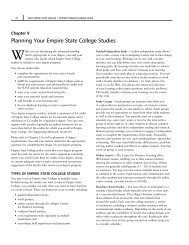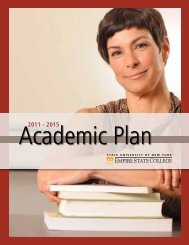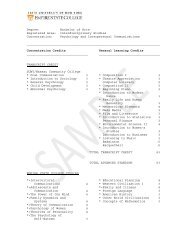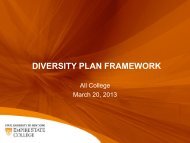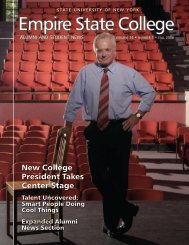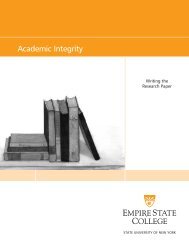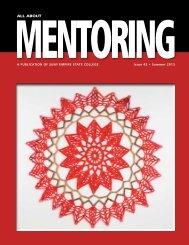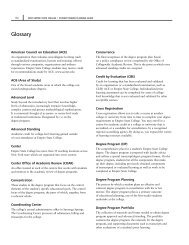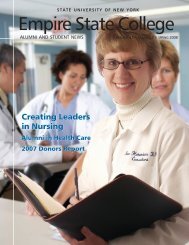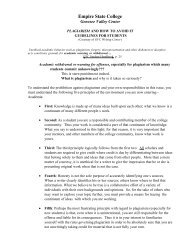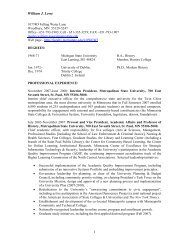All About Mentoring Spring 2011 - SUNY Empire State College
All About Mentoring Spring 2011 - SUNY Empire State College
All About Mentoring Spring 2011 - SUNY Empire State College
Create successful ePaper yourself
Turn your PDF publications into a flip-book with our unique Google optimized e-Paper software.
80<br />
Searching for Nonconsumers<br />
In a follow-up book, The Innovator’s<br />
Solution, Christensen and co-author Michael<br />
Raynor investigate strategies to create and<br />
sustain growth through disruption. Part<br />
of the book revisits the key themes of the<br />
earlier work, but the bulk of the book<br />
proposes more ideas for generating success.<br />
Among the more interesting discussions is<br />
a section on the personal digital assistant<br />
and smart phone markets, and the specific<br />
challenges of a firm like Blackberry-maker<br />
Research in Motion (2003: 1076). Since the<br />
book was written before the introduction<br />
of the iPhone, one can see how prescient<br />
Christensen and Raynor were in assessing<br />
the issues in the smart phone market.<br />
The authors reiterate a point made in the<br />
earlier book: disruptive approaches focus<br />
on nonconsumers as a market niche. The<br />
problem is that it can be hard to know who<br />
isn’t using a product while one is actually<br />
producing it or plans to produce it; we<br />
learn what people need most times from<br />
asking our existing customers rather than<br />
surveying the universe of people who do not<br />
use our product or service. Often, customers<br />
are discovered by accident. Christensen<br />
recounts the story of Honda management’s<br />
efforts to develop a motorcycle meant to<br />
compete with the classic highway-style<br />
Harley-Davidson; in the midst of this work,<br />
management discovered that the customers<br />
wanted Hondas for off-road use, which<br />
was an arena in which Harley was not<br />
competing at all. This ensured Honda’s<br />
success in the new market niche. In the<br />
short run, profit margins for the disruptive<br />
technologies are lower than they are for<br />
sustaining technologies. In fact, there is an<br />
inexorable pressure on business to move<br />
“up-market” and produce higher profit<br />
margin goods and services while happily<br />
leaving the low end, low profit margin to<br />
others. This is a great idea, that is, until<br />
the disruptive producers take over and the<br />
top end evaporates. Anyone old enough to<br />
recall vacuum tube technologies in radio<br />
and television, or gigantic DEC computers<br />
with dumb terminals, or eight-track tapes,<br />
can see that the introduction of disruptive<br />
technologies is a real strategic threat.<br />
The World of K-12 Education<br />
In Christensen’s more recent work, he<br />
and his co-authors have begun to apply<br />
his research to pressing national policy<br />
matters – health care and K-12 education.<br />
In Disrupting Class, he addresses issues that<br />
have arisen in the 1983 report, “A Nation<br />
in Crisis,” the debates over “No Child<br />
Left Behind,” and the controversy about<br />
the value or appropriateness of charter<br />
schools. They build on the work of Howard<br />
Gardner’s “multiple intelligences” to write<br />
about individualizing learning (not a new<br />
idea at <strong>Empire</strong> <strong>State</strong> <strong>College</strong>), but they also<br />
expand on ideas about nonconsumption.<br />
Here, the authors focus on the use of online<br />
learning not to supplement classroom<br />
teaching but rather to provide teaching in<br />
areas where courses would or could not be<br />
offered. One example they use is teaching<br />
Arabic online in public schools where no<br />
district could afford an individual instructor<br />
(Christensen, Horn, & Johnson, <strong>2011</strong>, p.<br />
2162-2171). They argue that high quality,<br />
even student-developed, learning tools and<br />
facilitated networks for sharing learning<br />
tools might dislodge textbooks and massmarket<br />
learning management systems and<br />
offer individualized solutions for students<br />
who learn differently (p. 2480-2495). In<br />
fact, the authors argue, based on their<br />
data analysis, these tools may acquire a<br />
25 percent market share and the tide may<br />
well have turned by 2014 in favor of digital<br />
and/or online learning against traditional<br />
classroom-based modes of teaching and<br />
learning – that is, the current “sustainable”<br />
educational technologies. Insofar as these<br />
innovative, disruptive modes of teaching<br />
and learning fill a need, even if they are not<br />
immediately better or obviously superior,<br />
they respond to a market for people who<br />
do not now use or do not feel as if they<br />
benefit from existing modes of teaching<br />
and learning.<br />
How have schools ended up in this<br />
situation On one level, it is not a failure<br />
of education or educators. Christensen and<br />
his co-authors repeatedly argue that schools<br />
and educators are consistently improving<br />
at the variety of tasks asked of them – test<br />
scores are often increasing, special education<br />
students are being mainstreamed into regular<br />
classrooms, and higher absolute numbers of<br />
students are graduating from high school. It<br />
is more the case that to continue to improve,<br />
they must standardize and routinize how<br />
to do their jobs so they can maximize the<br />
opportunity for an education and the quality<br />
of that education value for the maximum<br />
number of students.<br />
If education is a set of tasks to be measured<br />
by external criteria like testing, graduation<br />
numbers and mainstreaming data, it could<br />
be described as successful. If education is a<br />
tool to accomplish other life goals as defined<br />
by students, like getting a better job, making<br />
more money, having enough fun in school<br />
so they do not mind being there as opposed<br />
to playing sports or shopping, then is it<br />
working Christensen and his co-authors<br />
would argue no. Here is how the authors<br />
describe it:<br />
We believe that a core reason why so<br />
many students languish unmotivated in<br />
school or don’t come to class at all is that<br />
education isn’t a job that they are trying<br />
to do. Education is something they might<br />
choose to hire to do the job – but it isn’t<br />
the job. While we continue to do our<br />
research to understand this crucial issue,<br />
we hypothesize that there are two core jobs<br />
that most students try to do every day: They<br />
want to feel successful and make progress,<br />
and they want to have fun with friends …<br />
How do schools fare against … competitors<br />
as something that students can hire to<br />
be successful and have fun with friends<br />
Miserably in many cases. (Christensen,<br />
Horn, & Johnson, p. 2886-2903)<br />
Disrupting Higher Education<br />
What about the higher education arena<br />
and <strong>Empire</strong> <strong>State</strong> <strong>College</strong>’s role in it If<br />
Christensen and his co-authors are correct,<br />
and high schools are being transformed<br />
in the foreseeable future by the disruptive<br />
innovations they describe and which I<br />
note above (like online learning, studentdeveloped<br />
learning tools and facilitated<br />
learning networks), what might that<br />
mean for <strong>Empire</strong> <strong>State</strong> <strong>College</strong> and its<br />
competitor institutions that seek disruptive<br />
solutions: ideas and processes that are new<br />
to us. If they are correct that educators<br />
are fundamentally misunderstanding why<br />
students are “hiring” education in the first<br />
place, what could that mean for students<br />
who are “hiring” colleges and universities<br />
suny empire state college • all about mentoring • issue 39 • spring <strong>2011</strong>




